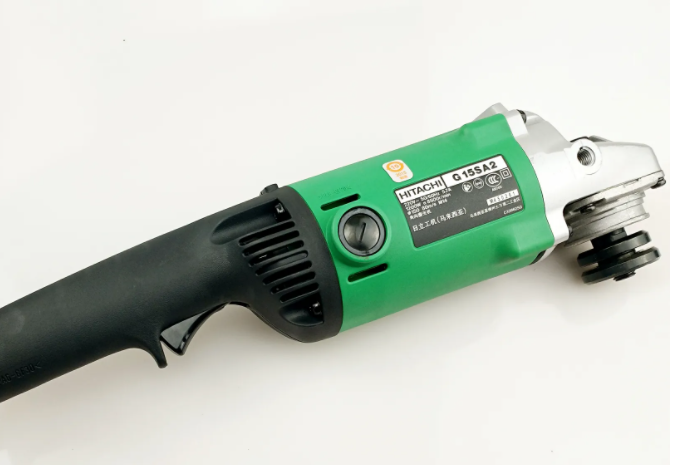Angle grinder disc is any disc designed to fit in an angle grinder and rotates at high speed to perform cutting and polishing operations. The angle grinder disc or wheel spins at anywhere from around 2,800 rpm to 12,000 rpm, depending on the brand and model of the tool and the settings you select.
Just by switching different discs in and out of the tool, you can use your angle grinder for a variety of applications. You can cut, grind, polish, carve, and more.
Moreover, you can work on a wide range of materials such as metal, stone, mortar, brick, or wood.
Now that you know what an angle grinder disc is, let’s check out some of the most common types of discs you can use and what you can do with them.
Large and small versions of these discs are available to suit the size of your angle grinder. For general purposes, consider a larger disc. For detailed work, consider a smaller disc.
1. Grinding Discs
It makes sense to talk first about grinding discs, also called “grit discs.” These are the discs you need if you want to grind metal or stone.
Angle Grinder Grinding Disc
Each disc features an abrasive compound consisting of grains and a bonding agent. You can choose a higher or lower grit depending on how fine or coarse you want the abrasive grains to be.
You may want to start with a low, coarse grit to speed through the beginning of a task, and then switch to a high grit for a smoother finish.
2. Cut-off Discs
Next, we have cut-off discs, also known as parting wheels. Choose this type of slim, tapered wheel if you want to cut metal stock.
Angle Grinder Cut-off Disc
You will find variations in thickness for cut-off discs. There are tradeoffs either way. The thinner the disc, the more easily it can slice into metal. But thin abrasive discs are brittle and more prone to breakage. The thicker the disc is, the sturdier it is, and the less likely it is to warp or fracture while you are using it.
So, you will need to weigh those pros and cons when choosing your cut-off discs. In either case, however, try not to push too hard or too fast into the metal. Doing that only makes it more likely you will damage the work and shatter the disc you are using.
3. Diamond Cutting Discs
If you are working with masonry or stones, a regular grit disc or cut-off disc won’t cut. You will need a diamond cutting disc which is a superior alternative. As the name implies, diamonds grits are embedded into the edges of a steel disc.
As diamond rates a 10 on the Mohs hardness scale, it makes for efficient cutting of concrete, tiles, stones, etc. It also offers superb durability.
Angle Grinder Diamond Discg
So, with a diamond disc, you can work more quickly and easily, even on harder metals. It will cost you more to purchase diamond discs, but they should outlast others, making them more cost-effective in the long run than they may initially appear.
4. Flap Discs
A flap disc is probably the best option when you need to do some sanding with an angle grinder.
Flap Disc for Angle Grinder
This type of disc uses abrasive (usually Aluminum Oxide) that is similar to a grit disc, but a whole lot finer. The main difference here is that instead of a single flat piece, the flap disc is made of multiple layers of overlapping abrasive sheets called flaps. Sometimes these are referred to as flap wheels, although that name is more appropriate for a radial flap wheel that you use on a drill or rotary tool.
Flap Disc Uses
With a flap disc, you can remove minor imperfections from a surface, remove rust, and polish the surface. Also, if there are fine grinding tasks that you cannot tackle using a regular grit disc, a flap disc may be appropriate. These types of angle grinder discs are often used in autobody shops, metalworking, and fabrication industries.
Worried about a flap disc overheating? You can try a ceramic sanding disc as an alternative.
5. Wire Wheels
One of the most distinctive-looking types of wheels you can get for your angle grinder is a wire wheel. You can use a wire wheel to remove paint or rust from metal.
Wire Wheels
You also can polish hard metal with a wire wheel—but keep in mind that on softer materials, using a wire wheel is more likely to lead to scratches than a smooth finish. Instead of featuring a cutting or grinding disc, this wheel includes clusters of bristles protruding in a radial formation. These bristles may be slender and straight, or they could be thick and twisted.
Twisted Wire Wheel
The type of wire disc you should get depends on the application you have in mind. The thick, twisted bristles are kind of like coarse grit on a grinder disc. Choose them for tasks that require more speed than precision. Then, switch to straight, fine bristles for work that requires more exactness.
Safety
You should always wear safety goggles when you are working with your angle grinder. But it is extra important with a wire wheel, as wires sometimes snap off. That is about the last thing you want flying into your eye.
I have seen a lot of novice users ignoring the basic safety practices when with a grinder. I wrote an entire guide on angle grinder safety since this is really important.
Post time: Mar-25-2022

